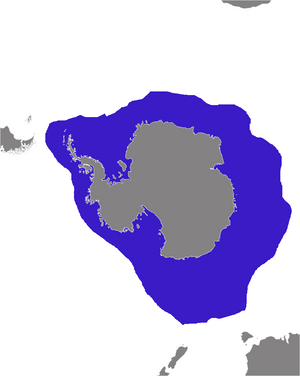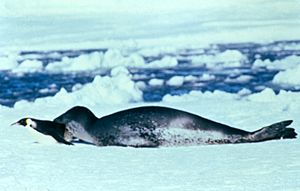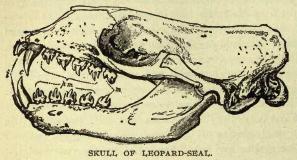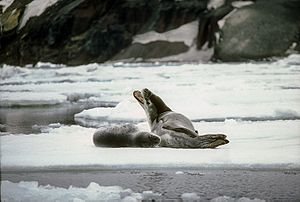Leopard seal
Quick facts for kids Leopard seal |
|
|---|---|
 |
|
| Conservation status | |
| Scientific classification | |
| Kingdom: | |
| Phylum: | |
| Class: | |
| Order: | |
| Superfamily: | |
| Family: | |
| Genus: |
Hydrurga
Gistel, 1848
|
| Species: |
H. leptonyx
|
| Binomial name | |
| Hydrurga leptonyx (Blainville, 1820)
|
|
 |
|
| Hydrurga leptonyx range map | |
The Leopard seal (Hydrurga leptonyx) is the second largest type of seal found in the Antarctic. Only the Southern Elephant Seal is bigger!
Leopard seals are not actually related to land leopards. They got their name because of their cool spots, which look a lot like a leopard's coat! These amazing animals are super good at living in their cold home. They also play a very important part in the Antarctic ecosystem.
Contents
About Leopard Seals
Leopard seals are some of the biggest seals in the Antarctic. Adult males are usually about 2.8 to 3.3 meters (9 to 11 feet) long. Females can be even longer, sometimes over 3.5 meters (11.5 feet)! A grown-up leopard seal can weigh between 200 and 500 kilograms (440 and 1100 pounds). Their smooth, sleek bodies are perfect for swimming fast in the chilly water.
They have a thick layer of blubber (fat) under their skin. This blubber keeps them warm in the freezing Antarctic waters. Their fur is dark gray or brownish-gray on their backs. Their bellies are usually lighter, a creamy white or light gray. This lighter color helps them hide from prey below, blending in with the bright ice and snow. The dark spots that give them their leopard-like look are all over their bodies.
These spots are more than just pretty! Scientists think that each seal's unique spot pattern is like a fingerprint. It helps them tell one seal from another!
Their strong bodies have powerful flippers. These flippers help them move with amazing speed and grace in the water. Leopard seals also have strong jaws with sharp, pointed teeth. These teeth are just right for the food they eat. They have big, expressive eyes too. These eyes help them see and hunt in the often cloudy Antarctic waters.
Where They Live
Leopard seals live along the coast of Antarctica. You can also find them on most sub-Antarctic islands. Sometimes, they even show up on the coasts of southern Australia, Tasmania, South Africa, New Zealand, and parts of South America. They really like areas with sea ice. You often see them near ice floes or where the ice is breaking up. Being close to sea ice gives them good places to hunt and rest.
Life Cycle and Behavior
Leopard seals usually spend most of their lives alone. But sometimes, you might see them in small groups. This happens especially during the breeding season. These groups are usually only together for a short time.
Breeding happens in the late spring and summer in the Antarctic. Before giving birth, female seals dig a round hole in the ice. This hole becomes a safe home for their baby. Female leopard seals give birth to just one pup. A newborn pup weighs about 30 kilograms (66 pounds).
The pup is born on the ice. It drinks its mother's milk for about 8 to 9 months. After that, it learns to hunt and live on its own. The mother gives the pup all the food it needs during this time. Male leopard seals do not help care for the pup. They go back to their solitary life after the breeding season.
Leopard seals can live for a long time. They are thought to live for about 26 years in the wild.
They make many different sounds. These include barks, growls, and whistles. Scientists are still learning about how they use these sounds to talk to each other.
What They Eat and How They Hunt

Leopard seals eat many different kinds of creatures. Young leopard seals mostly eat tiny krill, squid, and fish. As they get older, adult seals start eating bigger prey. This includes different types of penguins like king, adelie, rockhopper, gentoo, emperor, and chinstrap penguins. They also sometimes eat other seals, such as Weddell, crabeater, Ross, and young Southern elephant seals.
Their hunting skills are very impressive. They are incredibly fast and agile swimmers. They can chase down their prey with amazing speed. They use their powerful jaws to catch and hold their food. They are also known to use ambush tactics. This means they hide in the water and then suddenly burst out to catch their unsuspecting victims.
Who Hunts Them
Orcas (killer whales) and large sharks are the only natural predators of leopard seals.
Protecting Leopard Seals
Leopard seals are not currently considered to be endangered. However, their populations can be harmed by climate change. The melting of sea ice is a big problem for them. Sea ice is very important for their hunting and breeding grounds. Pollution from human activities can also affect their health and survival.
Cool Facts About Leopard Seals
- Leopard seals can dive incredibly deep. They sometimes go deeper than 500 meters (1640 feet)! This helps them hunt for food in the deep ocean.
- They can swim super fast, reaching speeds over 40 kilometers per hour (25 miles per hour) for short bursts.
- Leopard seals are very smart. You can see this in their clever hunting plans and how well they adapt to different places.
- Their thick blubber and fur are amazing ways they stay warm in the super cold water. They are also great at keeping their body temperature just right.
See also
 In Spanish: Foca leopardo para niños
In Spanish: Foca leopardo para niños





